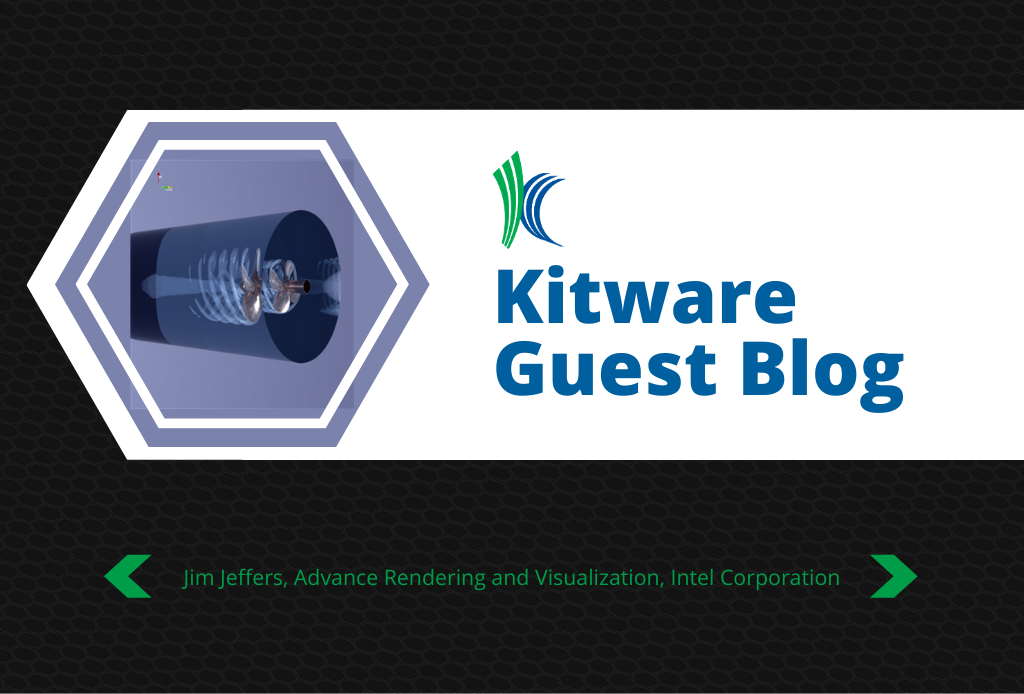Guest Blog: Intel on Upcoming ParaView 5.9 Release

The following is a guest post written by Jim Jeffers, senior director and senior principal engineer of advance rendering and visualization at Intel Corporation. Jeffers discusses the upcoming ParaView 5.9 release and its impact on exascale computing. Kitware will be sharing more details about ParaView 5.9 soon.
“Exascale, Exascale, Exascale!”…. A growing mantra for almost a decade. Starting with questions like, “Will the HPC industry be able to build a machine 1000x more performant like we did going from Teraflops to Petaflops? Will it be a power-sucking beast? Will we even be able to write codes to effectively use such performance?” Actually all great questions, without answers just 8-10 years ago when the hard, detailed and conscientious work started, and continues on. We are finally on the doorstep of building machines with a quintillion double precision floating point ops per second. Many, scientists, engineers, data center design experts, government and industry leaders are driving to answer these questions.

“ParaView v5.9 is a major step forward in delivering Exascale ready computation and visualization. Intel’s strong collaboration with Kitware to help incorporate the many advanced and scalable capabilities of Intel® oneAPI Rendering Toolkit, particularly Intel® OSPRay v2.4, will help scientists worldwide better understand and communicate the nuances of their evermore complex data. “
— Jim Jeffers, Intel Corporation
For the HPC sub-domain that Kitware and my team at Intel address (3D visual analysis or ‘visualization’), we’ve spent close to six years helping enable machines to do “mo’ better,” larger and larger scale visual analysis. This has been delivered with ParaView including LIGO driven Black Hole with Gravitational Wave Science with Stephen Hawking and his team, new higher resolution Weather and Climate analysis with Max Plank Institute for Meteorology, DKRZ weather climate research, Los Alamos National Labs, Argonne National Labs science and engineering research, NIU medical and biological process studies, and LRZ Supercomputing Center research. We’ve also collaborated with the industry to enable a variety of new, higher fidelity and higher performant solutions from the Department of Energy labs, the National Science Foundation funded facilities such as Texas Advanced Computing Center (TACC), Universities and other leaders.
These references highlight the relevance of this ‘clockwork like’ twice-annual release of ParaView, with its unassuming version number of v5.9. To me this is a commencement, as it marks the foundation for a new beginning and preparedness for the exascale computing era which many of us have dedicated years towards. The two things that excite me most:
1) The integration of Intel® OSPRay 2.4 replacing OSPRay v1.8 represents an important redesign and expansion of capabilities, including high-fidelity volumetric path tracing among other improvements. OSPRay 2.x is the culmination of usage and broad industry feedback that enables enhanced scalability and effective new exciting lighting, materials and functional ray tracing features that equates to simply more effective visualizations.
2) The first integration (more to come) for In Situ compute and visualization software methods will take advantage of Intel® Optane Persistent Memory. This will drive interactive visualization functionality through the Catalyst data bridge API. This will deliver a compatibility link in compute codes directly with ParaView visual analysis. This capability might feel straightforward but in fact is a game changer for medium to large-scale computation (e.g. Peta and Exa – scale) where I/O (data copies in and out of memory) becomes a major blocker to successful science computation and analysis. A look at this capability can be found with our SC20 joint demo with Kitware and TACC using the public OpenFOAM propeller dataset. We show live screen capture of accumulation of nearly 1000 time-steps of about 1TB of calculated data (system shown is capable of 3000+ timesteps), and the ability to analyze, interactively with time-step animation while the computations happen co-incidentally!
I call the result of these multi-year efforts the ability to deliver “Real-Time Science.” By taking on a challenge of exascale computing with high expectations for world-changing science, we are addressing high hurdles of analyzing massive, growing, complex data, and enabling something possibly unexpected. This ability begins a new ‘Exascale level discovery,’ from the moment the computation code outputs its first data. If you are interested, take a deeper look in the virtual talk in the Intel SC20 Virtual Booth called “Real-Time Science and Discovery.”
So, I recommend you ‘commence’ with ParaView v5.9 and its leap forward in readiness and capability for your computing and visualization today, and for the burgeoning age of exascale computing. Fiction is now becoming reality thanks to ParaView’s delivery of exascale computation.
Notices & Disclaimers
Intel technologies may require enabled hardware, software, or service activation.
No product or component can be absolutely secure.
© Intel Corporation. Intel, the Intel logo, and other Intel marks are trademarks of Intel Corporation or its subsidiaries. Other names and brands may be claimed as the property of others.
Good post! Typo in the last sentence “Fiction is now becoming relating …”.
“relating” should be “reality”